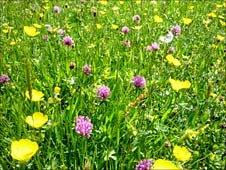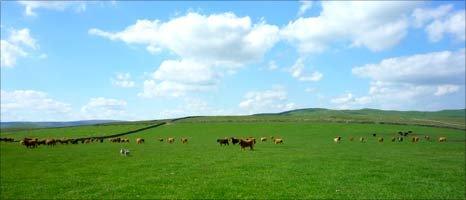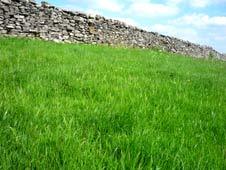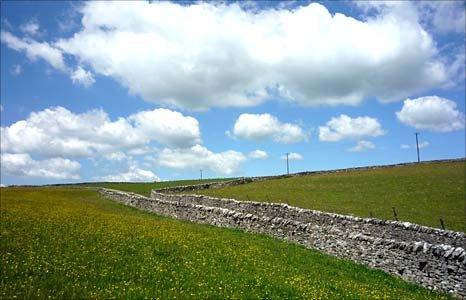Conservationists warn of hay meadow decline
- Published
"Constable? Turner? Give me a hay meadow any day," says Tony Bullough as we get our first glimpse of New House Farm.
And the National Trust warden has a point - the fields surrounding this small farm are a glorious sight.
Perched in a small valley near the village of Malham, in the Yorkshire Dales, the meadows provide a blaze of colour in the more typical green of the rural landscape.
Yellow buttercups mingle with pink clover and red sorrel flowers, all scattered in amongst a seemingly endless number of grass species.

Traditional hay meadows contain many different plant species
Pollen-laden bumblebees buzz from flower to flower, dodging fluttering butterflies; curlews and lapwings soar overhead.
Traditional hay meadows like this one used to be the mainstay of rural Britain.
The grass and flower-packed fields were set aside and left to grow from spring to mid-summer, before being cropped and then dried out to provide fodder for livestock during the harsh winter months.
But as farming methods have changed and intensified, these pretty meadows have all but vanished from the face of the countryside.
Ecologist Professor John Rodwell says: "Over England and Wales, the last reliable overall survey showed us that in the last century we have lost about 97% of the hay meadows that we had."
This study was carried out in the 1980s, and more recent surveys have revealed that the decline has been continuing around the whole of the UK, he explains.
"We've only got a tiny fraction left now - agriculture is a different sort of operation now," he adds.

Lee Gate Farm has replaced its hay meadows with silage fields to feed its livestock
We head next door to Lee Gate Farm to meet Frank Carr.
This farm has been in his family since 1927.
"When I was a boy, all our meadows were the same as those that you've seen," he says.
"But as time has gone on, progress and lack of staff has meant that we have had to move with the times."
Green silage fields have replaced the traditional hay meadows.
These fields contain just a few grass species, such as sturdy rye, which is grown, then cut and fermented to provide a wet feed for livestock.
Silage fields like these are a more economically viable option for modern farmers, says Mr Carr.
"Hay time involves much more manual work and a lot more people," he explains.
"With silage making, you can use much bigger machinery and do a lot in a little time."
The success of the crop is also less dependent on weather.
"Hay time depends on a good five days of good weather, whereas with silage, if you have 24 hours of good weather you can get a good crop in," he adds.
Wildlife losses
But the loss of hay meadows is having a worrying impact on biodiversity, says Professor Rodwell.
"When you shift to a more intensive form of agriculture, first of all the diversity drops. Then the differences from field to field - the particularity of the place - is lost, every field looks like every other.

Silage fields contain fewer grass species
"And then all of the other associated organisms - the butterflies, the bees, birds - they seem to decline too."
It is also extremely difficult to "turn back the clock" once a hay meadow has been transformed into a more uniform pasture.
"Once a hay meadow is gone, it's gone," he says.
Organisations like the National Trust and Natural England want to safeguard the last few remaining hay meadows.
Pete Brash, an ecologist from the National Trust, says: "We want to keep the last few in as good a condition as possible - it is really important to conserve them as they are incredibly important for wildlife and they also have a huge cultural significance."
The National Trust has been purchasing farms and hay meadows, such as New House Farm, through auctions to maintain and protect them where possible.

Conservation groups want to halt the decline
Farmers throughout the UK are also offered incentives to protect their hay meadows.
Dr Richard Jefferson, a senior specialist from Natural England, said: "We have been notifying the best ones as Sites of Special Scientific Interest (SSSI) through the Countryside and Wildlife Act (in Northern Ireland they are designated as Areas of Special Scientific Interest).
"And that actually gives them statutory protection, allowing us to control what actually happens on the site.
"Outside of this other hay meadows are also eligible for the environmental stewardship scheme.
"We are very dependent on these agri-evironment payments to provide this incentive, because [traditional hay meadows] have relatively low productivity compared with silage fields or other hay fields which receive artificial fertilizers."
Some farmers are now also publicising how their animals are fed to market their meat.
Dr Jefferson said: "At the moment this is quite general, but to see farmers saying 'this is a meat reared off species-rich farmland' would be brilliant. It is obviously a niche market, but this could help."
With schemes like these in place, conservation organisations hope the decline in hay meadows is slowing.
But they warn that we cannot be complacent, or hay meadows like those at New House Farm could risk becoming a hazy memory of rural summers past.
- Published19 June 2010